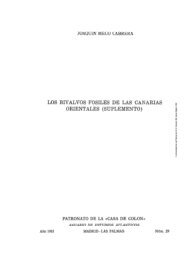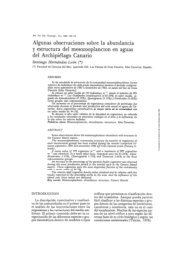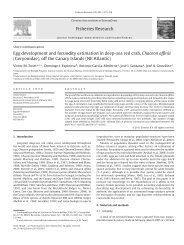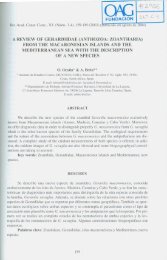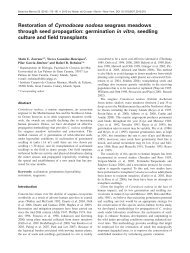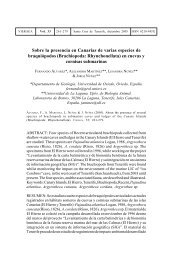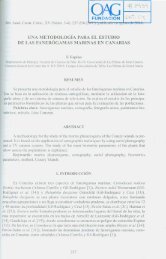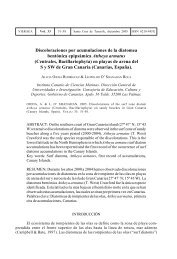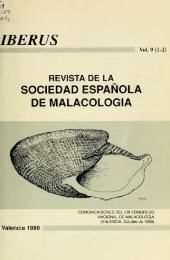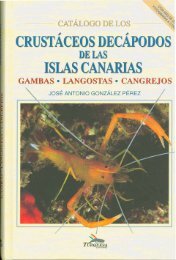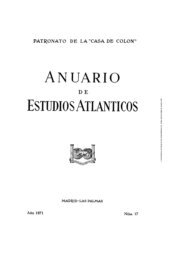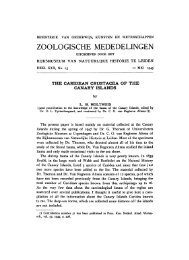- Page 1:
Listagem dos fungos, fl ora e fauna
- Page 4 and 5:
Composição da capa e da obra | Fr
- Page 6 and 7:
Edição e financiamento | Edition
- Page 8 and 9:
6 As plantas vasculares (Pteridophy
- Page 10 and 11:
Coleoptera (Coordenação | Coordin
- Page 12 and 13:
Lepidoptera 339 ANTÓNIO M. FRANQUI
- Page 14 and 15:
PREFACE During the history of Weste
- Page 16 and 17:
3. A lista apresentada nos Capítul
- Page 18 and 19: (cerca de 0,5 km 2 , 100 m de altit
- Page 20 and 21: Os artrópodes (grupo que inclui, e
- Page 22 and 23: área/habitat - baseado na Teoria d
- Page 24 and 25: Quadro 2. | Table 2. Diversidade de
- Page 26 and 27: ação a longo prazo (e.g. na lauri
- Page 29 and 30: Resumo 1. Os modelos preditivos de
- Page 31 and 32: número de lacunas nos mapas (Hurlb
- Page 33 and 34: al. 2007, 2008), para prever os efe
- Page 35 and 36: Locality data data Environmental da
- Page 37 and 38: (a) (b) (c) (d) Figura 5. Espécies
- Page 39 and 40: (a) (b) (c) Figura 8. Distribuiçã
- Page 41 and 42: (a) (b) (c) (d) Figura 11. Distribu
- Page 43 and 44: mico com grande diversidade em regi
- Page 45 and 46: cies e elucidar acerca das razões
- Page 47 and 48: conhecida como Verdilhão, é uma e
- Page 49 and 50: secos no Verão. O mapa de distribu
- Page 51 and 52: Carabídeos (Coleoptera, Carabidae)
- Page 53 and 54: influência na distribuição desta
- Page 55 and 56: de amostras disponíveis, preferimo
- Page 57 and 58: Izquierdo, I., Martín, J.L., Zurit
- Page 59 and 60: Resumo 1. Os fungos desempenham um
- Page 61 and 62: tribuições para o conhecimento do
- Page 63 and 64: Quadro 1. | Table 1. (cont.) Grande
- Page 65 and 66: Quadro 1. | Table 1. (cont.) Grande
- Page 67: Tendo em consideração a ressalva
- Page 71 and 72: 8. Referências bibliográficas | R
- Page 73: CAPÍTULO 3.1 | CHAPTER 3.1 LISTA D
- Page 76 and 77: D FUNGI MA M PS D S Ordem Capnodial
- Page 78 and 79: D FUNGI MA M PS D S Ordem Eurotiale
- Page 80 and 81: D FUNGI MA M PS D S Discinaceae Gyr
- Page 82 and 83: D FUNGI MA M PS D S Ordem Xylariale
- Page 84 and 85: D FUNGI MA M PS D S Bolbitiaceae (c
- Page 86 and 87: D FUNGI MA M PS D S Pluteaceae Aman
- Page 88 and 89: D FUNGI MA M PS D S Pisolithaceae P
- Page 90 and 91: D FUNGI MA M PS D S Phanerochaetace
- Page 92 and 93: D FUNGI MA M PS D S Phragmidiaceae
- Page 94 and 95: D FUNGI MA M PS D S Ordem Tilletial
- Page 97 and 98: Resumo 1. Os líquenes são organis
- Page 99 and 100: A lista de líquenes da Madeira e S
- Page 101 and 102: Dos 12 taxa endémicos indicados pa
- Page 103 and 104: Açores - 43.9% Figura 3. Similitud
- Page 105: 6. Referências bibliográficas | R
- Page 109 and 110: D LICHENS MA M PS D S Ordem Arthoni
- Page 111 and 112: D LICHENS MA M PS D S Ordem Mycocal
- Page 113 and 114: D LICHENS MA M PS D S Cladoniaceae
- Page 115 and 116: D LICHENS MA M PS D S Parmeliaceae
- Page 117 and 118: D LICHENS MA M PS D S Physciaceae (
- Page 119 and 120:
D LICHENS MA M PS D S Ramalinaceae
- Page 121 and 122:
D LICHENS MA M PS D S Collemataceae
- Page 123 and 124:
D LICHENS MA M PS D S Porinaceae (c
- Page 125 and 126:
Resumo 1. Pelas reduzidas dimensõe
- Page 127 and 128:
caronésia, onde ocorre uma grande
- Page 129 and 130:
Recentemente, Losada -Lima et al. (
- Page 131 and 132:
Quadro 1. | Table 1. Diversidade do
- Page 133 and 134:
S 20 18 16 14 12 10 8 6 4 2 0 Lejeu
- Page 135 and 136:
páticas. Por outro lado, existem d
- Page 137 and 138:
Num estudo recente foi comparada a
- Page 139 and 140:
Açores - 62.3% 7. Considerações
- Page 141 and 142:
O aumento do conhecimento acerca do
- Page 143:
Sim -Sim, M., Esquível, M.G., Font
- Page 147 and 148:
D BRYOPHYTA MA M PS D S Ordem Sphag
- Page 149 and 150:
D BRYOPHYTA MA M PS D S Ditrichacea
- Page 151 and 152:
D BRYOPHYTA MA M PS D S Ordem Hypna
- Page 153 and 154:
D BRYOPHYTA MA M PS D S Orthotricha
- Page 155 and 156:
D BRYOPHYTA MA M PS D S Marchantiac
- Page 157 and 158:
D BRYOPHYTA MA M PS D S Plagiochila
- Page 159 and 160:
Resumo 1. A presente lista de plant
- Page 161 and 162:
plausível uma origem mais antiga d
- Page 163 and 164:
a manter a homogeneidade com o prin
- Page 165 and 166:
Quadro 1. | Table 1. Número de tax
- Page 167 and 168:
S 30 25 20 15 10 5 0 Asteraceae Bra
- Page 169 and 170:
S 600 500 400 300 200 100 0 154 480
- Page 171 and 172:
S 150 125 100 75 50 25 0 1750 1760
- Page 173 and 174:
S S 96 12.94 13.95 14.81 6 2 Figura
- Page 175 and 176:
Canárias arquipélago (7447 km2 )
- Page 177 and 178:
Quadro 4. | Table 4. Espécies prot
- Page 179 and 180:
7. Referências bibliográficas | R
- Page 181:
CAPÍTULO 6.1 | CHAPTER 6.1 LISTA D
- Page 184 and 185:
D PTERIDOPHYTA & SPERMATOPHYTA MA M
- Page 186 and 187:
D PTERIDOPHYTA & SPERMATOPHYTA MA M
- Page 188 and 189:
D PTERIDOPHYTA & SPERMATOPHYTA MA M
- Page 190 and 191:
D PTERIDOPHYTA & SPERMATOPHYTA MA M
- Page 192 and 193:
D PTERIDOPHYTA & SPERMATOPHYTA MA M
- Page 194 and 195:
D PTERIDOPHYTA & SPERMATOPHYTA MA M
- Page 196 and 197:
D PTERIDOPHYTA & SPERMATOPHYTA MA M
- Page 198 and 199:
D PTERIDOPHYTA & SPERMATOPHYTA MA M
- Page 200 and 201:
D PTERIDOPHYTA & SPERMATOPHYTA MA M
- Page 202 and 203:
D PTERIDOPHYTA & SPERMATOPHYTA MA M
- Page 204 and 205:
D PTERIDOPHYTA & SPERMATOPHYTA MA M
- Page 206 and 207:
D PTERIDOPHYTA & SPERMATOPHYTA MA M
- Page 208 and 209:
D PTERIDOPHYTA & SPERMATOPHYTA MA M
- Page 211 and 212:
Resumo Apresenta -se uma lista prel
- Page 213 and 214:
D PLATYHELMINTHES MA M PS D S Ordem
- Page 215 and 216:
Resumo 1. O filo Nematoda constitui
- Page 217 and 218:
- Madeira; PS - Porto Santo; D - De
- Page 219 and 220:
A riqueza em número de espécies d
- Page 221 and 222:
presentam o maior número de espéc
- Page 223:
CAPÍTULO 8.1 | CHAPTER 8.1 LISTA D
- Page 226 and 227:
D NEMATODA MA M PS D S Ordem Oxyuri
- Page 229 and 230:
Resumo 1. O arquipélago da Madeira
- Page 231 and 232:
A primeira coluna (D) apresenta o t
- Page 233 and 234:
quais endémicos e alguns deles exc
- Page 235 and 236:
S 800 700 600 500 400 300 200 100 0
- Page 237 and 238:
áreas protegidas já existentes, p
- Page 239:
CAPÍTULO 9.1 | CHAPTER 9.1 LISTA D
- Page 242 and 243:
D MOLLUSCA MA M PS D S Clausiliidae
- Page 244 and 245:
D MOLLUSCA MA M PS D S Hygromiidae
- Page 246 and 247:
D MOLLUSCA MA M PS D S Oxychilidae
- Page 248 and 249:
vespas, formigas), com 610 taxa, os
- Page 250 and 251:
ções: M - Madeira; PS - Porto San
- Page 252 and 253:
Quadro 1. | Table 1. Diversidade do
- Page 254 and 255:
4. Evolução em ilhas hiperdiversa
- Page 256 and 257:
Quadro 2. | Table 1. (cont.) Grande
- Page 258 and 259:
Tendo em conta o grande declive na
- Page 260 and 261:
Other insects 21% Coleoptera 38% Ma
- Page 262 and 263:
sivamente para as comunidades de ar
- Page 264 and 265:
8. Referências bibliográficas | R
- Page 266 and 267:
Mclachlan, R. (1882) The Neuroptera
- Page 268 and 269:
Referências bibliográficas | Refe
- Page 270 and 271:
deiros. Dado que todas as espécies
- Page 272 and 273:
Solenopsis (Diplorhoptrum) sp. 2. E
- Page 274 and 275:
COORDENADORES TAXONÓMICOS TAXONOMI
- Page 276 and 277:
THYSANOPTERA Richard zur Strassen F
- Page 278 and 279:
DIPTERA (Ulidiidae (+ Otitidae)) El
- Page 280 and 281:
HYMENOPTERA (CYNIPOIDEA) Jose Luis
- Page 282 and 283:
D ARTHROPODA MA M PS D S Ordem Ixod
- Page 284 and 285:
D ARTHROPODA MA M PS D S Eriophyida
- Page 286 and 287:
D ARTHROPODA MA M PS D S Gnaphosida
- Page 288 and 289:
D ARTHROPODA MA M PS D S Sparassida
- Page 290 and 291:
D ARTHROPODA MA M PS D S Porcellion
- Page 292 and 293:
D ARTHROPODA MA M PS D S Julidae (c
- Page 294 and 295:
D ARTHROPODA MA M PS D S Onychiurid
- Page 296 and 297:
D ARTHROPODA MA M PS D S Meinertell
- Page 298 and 299:
D ARTHROPODA MA M PS D S Tettigonii
- Page 300 and 301:
D ARTHROPODA MA M PS D S Cicadellid
- Page 302 and 303:
D ARTHROPODA MA M PS D S Lygaeidae
- Page 304 and 305:
D ARTHROPODA MA M PS D S Tingidae (
- Page 306 and 307:
D ARTHROPODA MA M PS D S Pseudococc
- Page 308 and 309:
D ARTHROPODA MA M PS D S Aphididae
- Page 310 and 311:
D ARTHROPODA MA M PS D S Thripidae
- Page 312 and 313:
D ARTHROPODA MA M PS D S Anthicidae
- Page 314 and 315:
D ARTHROPODA MA M PS D S Carabidae
- Page 316 and 317:
D ARTHROPODA MA M PS D S Chrysomeli
- Page 318 and 319:
D ARTHROPODA MA M PS D S Curculioni
- Page 320 and 321:
D ARTHROPODA MA M PS D S Curculioni
- Page 322 and 323:
D ARTHROPODA MA M PS D S Hydrophili
- Page 324 and 325:
D ARTHROPODA MA M PS D S Oedemerida
- Page 326 and 327:
D ARTHROPODA MA M PS D S Staphylini
- Page 328 and 329:
D ARTHROPODA MA M PS D S Staphylini
- Page 330 and 331:
D ARTHROPODA MA M PS D S Ordem Siph
- Page 332 and 333:
D ARTHROPODA MA M PS D S Ceratopogo
- Page 334 and 335:
D ARTHROPODA MA M PS D S Dolichopod
- Page 336 and 337:
D ARTHROPODA MA M PS D S Muscidae n
- Page 338 and 339:
D ARTHROPODA MA M PS D S Psychodida
- Page 340 and 341:
D ARTHROPODA MA M PS D S Syrphidae
- Page 342 and 343:
D ARTHROPODA MA M PS D S Blastobasi
- Page 344 and 345:
D ARTHROPODA MA M PS D S Gracillari
- Page 346 and 347:
D ARTHROPODA MA M PS D S Pterophori
- Page 348 and 349:
D ARTHROPODA MA M PS D S Apidae END
- Page 350 and 351:
D ARTHROPODA MA M PS D S Braconidae
- Page 352 and 353:
D ARTHROPODA MA M PS D S Encyrtidae
- Page 354 and 355:
D ARTHROPODA MA M PS D S Formicidae
- Page 356 and 357:
D ARTHROPODA MA M PS D S Ichneumoni
- Page 358 and 359:
D ARTHROPODA MA M PS D S Scelionida
- Page 360 and 361:
8. A análise do estatuto de conser
- Page 362 and 363:
Uma espécie só é considerada nat
- Page 364 and 365:
áreas estudadas, uma ordem ocorre
- Page 366 and 367:
% 100 90 80 70 60 50 40 30 20 10 0
- Page 368 and 369:
ve Species database. Global Invasiv
- Page 370 and 371:
British Museum, referido por Dobson
- Page 372 and 373:
dugesii inferred from mtDNA sequenc
- Page 375 and 376:
D CHORDATA MA M PS D S Ordem Anguil
- Page 377:
D CHORDATA MA M PS D S END Regulida
- Page 380 and 381:
Anacyclus radiatus Loisel. subsp. r
- Page 382 and 383:
Aphthona convexior Lindberg, 1950 A
- Page 385:
ÍNDICE TAXONÓMICO | TAXONOMIC IND
- Page 388 and 389:
Aelia klugii (ver Apêndice I) Aelu
- Page 390 and 391:
Anops solifugus (ver Anillobius sol
- Page 392 and 393:
Asplenium septentrionale subsp. sep
- Page 394 and 395:
Brachycephalus madeirae (ver Dichro
- Page 396 and 397:
Carpophilus marginellus ...........
- Page 398 and 399:
Chrysomya megacephala .............
- Page 400 and 401:
Crassula tillaea ..................
- Page 402 and 403:
Dichodontium pellucidum var. flaves
- Page 404 and 405:
Enicospilus faciator ..............
- Page 406 and 407:
Fissidens barretoi (ver Fissidens t
- Page 408 and 409:
Gomphidiaceae .....................
- Page 410 and 411:
Hexapoda ..........................
- Page 412 and 413:
Isotomina coeruleogrisea (ver Crypt
- Page 414 and 415:
Lemnaceae .........................
- Page 416 and 417:
Lucasius normani (ver Porcellio nor
- Page 418 and 419:
Micaria septempunctata (ver Micaria
- Page 420 and 421:
Nerine sarniensis .................
- Page 422 and 423:
Oxalidaceae .......................
- Page 424 and 425:
Phalaris altissima (ver Phalaris aq
- Page 426 and 427:
Plectocarpon macaronesiae .........
- Page 428 and 429:
Psilolechia lucida ................
- Page 430 and 431:
Rhomphaea nasica ..................
- Page 432 and 433:
Sclerococcum tephromelarum ........
- Page 434 and 435:
Sphaericus ambiguus ...............
- Page 436 and 437:
Tegenaria domestica ...............
- Page 438 and 439:
Tricholomopsis rutilans ...........
- Page 440:
Vicia lutea subsp. lutea ..........



